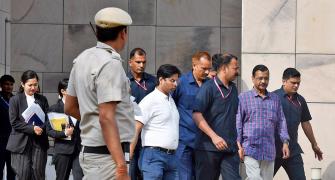Her friends explained to Kulkarni, "She has a debt of Rs 40 lakh and we want to know our options." The details were scary.
Nikita Kasturi (name changed), who works for a multinational company, had seven personal loans, an auto loan and six credit cards. And all that with a princely take-home salary of Rs 30,000.
Lenders had caught on in the last few months that she could not pay them. The result: daily calls to her office and residence. She feared that she would lose the job if the company's director came to know about her financial mess.
"In most cases, a debtor has a minimum of four cards and at least two personal loans. And to service one loan, people start borrowing from other sources, thereby aggravating the problem and leading to a debt trap," said Kulkarni.
Kasturi's case is not isolated. Such instances are on the rise because of reckless borrowing and spending through credit. No wonder, even the Reserve Bank of India (RBI) is worried. In its mid-term annual policy review to set up pilot projects for debt counselling in urban as well as rural areas.
Faced with a debt trap, here are a few things that you should consciously do.
Inform your spouse/parents: The biggest mistake a person makes is keeping their family in the dark. And then out of nowhere, when recovery agents start calling or visiting the house, they are shocked.
Credit counselling centres say that this happens in 7 out of 10 cases. Even in the case of Kasturi, she kept her credit woes a secret, fearing dire consequences, if her family members came to know about her escapades with money.
According to financial planner Suresh Sadagopan, informing a spouse is a big help. For instance, when a wife is aware of the loan, she can actually cut down on the expenses to help increase the monthly outgo.
Plan for repayment: List down the routine monthly expenses and narrow down on an amount you can spare towards repayment of the debt. And follow that regime diligently till the entire amount has been wiped off.
Swap high-cost loans with low-cost ones: In the majority of cases, the reason for debt trap is the high interest rate payout that customers do not anticipate. Banks charge as much as 45-50 per cent on credit cards and upwards of 20 per cent on personal loans.
To get rid of the high interest loans, look to borrow cheap. This can include National Savings Certificate (NSC), loan against life insurance, Kisan Vikas Patra (KVP), shares, mutual funds, gold and fixed deposits (FDs). One can borrow against these securities and get a much cheaper loan. Experts suggest that NSC and KVP should be the first option to borrow against as they are illiquid. By the time they mature, a person can square off the loans. Even loans against securities can be taken at the rate of 14-16 per cent a year.
One-time settlement: If the bank allows the defaulter to settle all the dues in one shot, the person should work out a one-time-settlement (OTS) with the lenders. The process that can be followed is this. Approach the bank, list down all the loans and dues you own to various financial institutions, without mentioning their names. Express your desire for an OTS. This will give the impression to the bank that you are willing to pay back.
To avoid any loans from becoming non-performing assets (NPAs), banks are willing for a settlement if the borrower is willing to pay off the principal amount. On a case-to-case basis, the settlement can be made in instalments as well.
Restructure the loans: If OTS is not possible and your earnings cannot match up to the monthly outflow of dues, ask the bank to restructure the loan. Draft a letter that states your current financial condition. Mention the money you need to pay off. Give a clear picture of your net salary and request the bank to restructure.
The banks will restructure the loan, wherein higher equated monthly instalments (EMI) are charged as and when the financial position of the borrower improves.
In case, the default has occurred due to a job loss or uncertain medical expenses, banks can also waive off the penalty charges and accumulated interest on the default amount. Madan Mohan, a counsellor at Disha Financial Counselling, says, "When one negotiates with credit card companies to settle the dues, the issuers do waive off over-limit and other finance charges."
Also, convert credit card dues into a loan. The customer can pay the outstanding as equated monthly instalments (EMIs). The interest can come down to less than half (between 22-24 per cent).
Declare insolvency: In a worst-case scenario, if the person has lost all his money due to an unfortunate event and neither has any assets nor any source of income, the only way out is filing a petition for insolvency. The borrower goes to the bank and declares himself bankrupt. The court takes over all the assets, including the house, and liquidates them to repay the lenders.
But this is a complicated procedure, wherein the court conducts a thorough due diligence of the person's financial position. The entire procedure can take up to three years.







